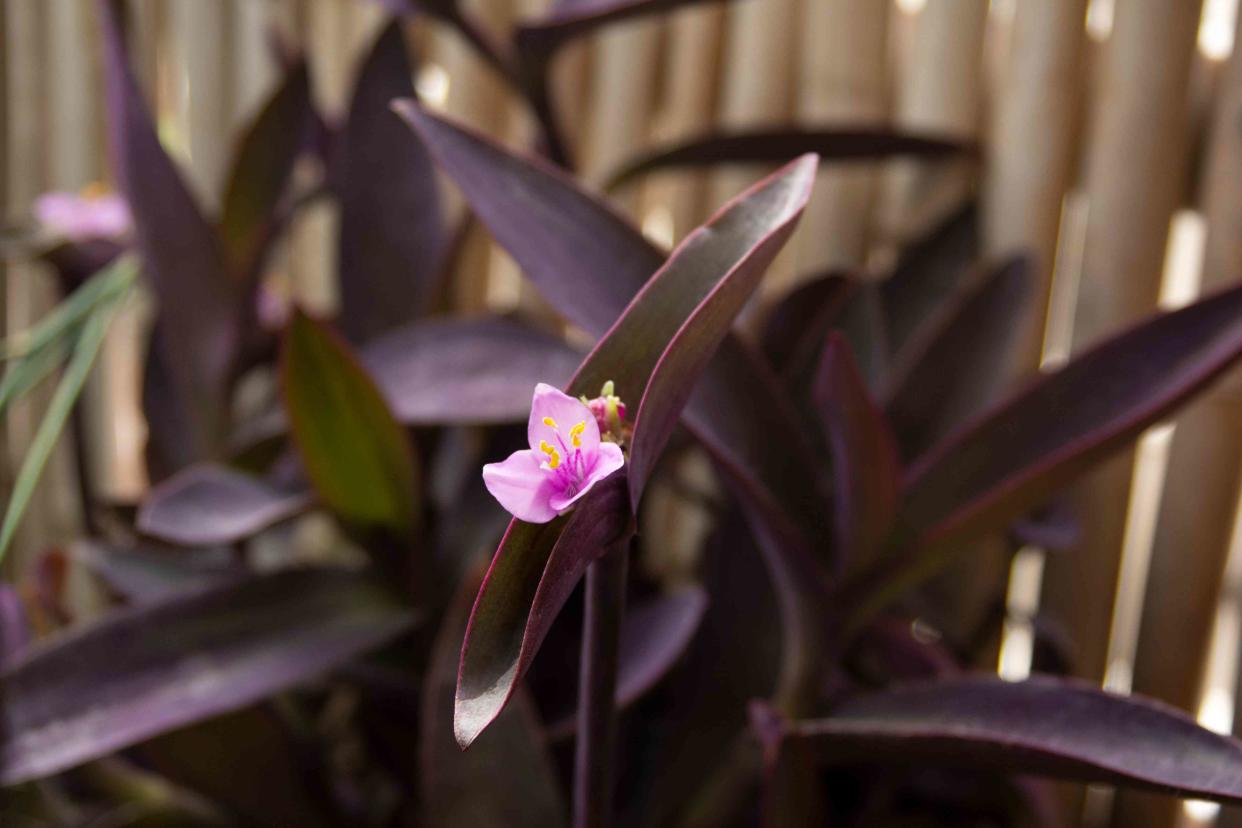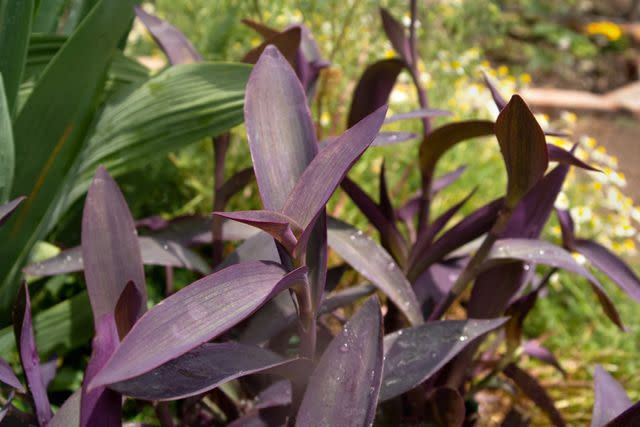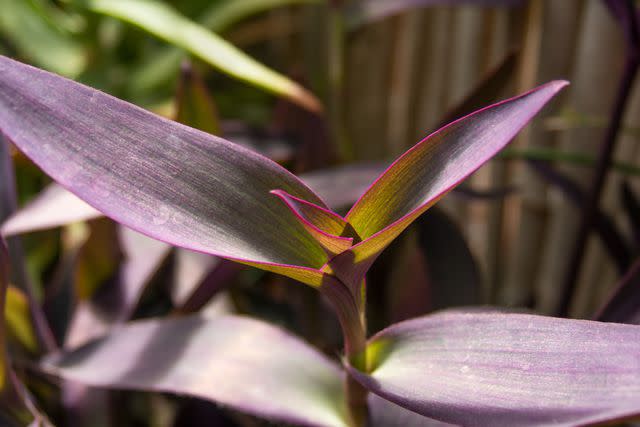How to Grow and Care for Purple Heart

The Spruce / Heidi Kolsky
Fact checked by Emily Estep
Purple heart, also known as purple spiderwort, is aptly named for its iconic purple stems that grow small flower clusters, ranging from violet to pink. This vining species is often grown as an annual, as a houseplant, and as a perennial in zones where it's hardy. Purple heart thrives in full sun and a variety of soil types.
Like other species of the Tradescantia genus, purple heart can be mildly toxic to pets and people.
Common Name | Purple heart, purple spiderwort |
Botanical Name | Tradescantia pallida |
Family | Commelinaceae |
Plant Type | Perennial, vine |
Mature Size | 1-2 ft. tall, 1-2 ft. wide |
Sun Exposure | Full, partial |
Soil Type | Loamy, sandy, clay, silt, moist but well-drained |
Soil pH | Acidic, neutral, alkaline |
Bloom Time | Summer |
Flower Color | Pink |
Hardiness Zones | 7-11 (USDA) |
Native Area | Central America |
Toxicity | Toxic to people, pets |
Purple Heart Care
Purple heart is often referred to as a “creeping perennial” due to the fact that it will spread out quickly as it grows. Here are the main care requirements for purple heart:
Choose a sunny location (ideally six hours or more of direct sunlight outside, or the sunniest spot in your home indoors), though purple heart can tolerate partial shade.
Prepare well-draining soil.
Water thoroughly once the soil dries out, though this plant can withstand some drought.
Fertilize at the beginning of the growing season if grown outdoors as a perennial; or fertilize once or twice in spring/summer if grown as a houseplant.

The Spruce / Heidi Kolsky

The Spruce / Heidi Kolsky
Invasive Species
Purple heart is considered to be invasive in various parts of the world and in some corners of the United States, such as Florida. This vigorous grower can quickly smother other plants in zones where it survives the winter (USDA zones 7-11).
Light
Planting your purple hearts in full sun can help ensure that they grow the vibrant purple stems. The plant can also grow in partial shade, but its stem is more likely to appear green than purple.
It's best to introduce these plants to brighter conditions over time, however, as too much direct sunlight all at once can lead to foliage burn.
Soil
Purple heart plants will grow best in soil that's lightweight, porous, and moist. Good drainage is a must. The plant tolerates a wide pH range from slightly acidic to slightly alkaline.
Water
Purple heart is considered to be drought-tolerant, and it will not require a great deal of watering. For best growth, however, it is best not to let the plant sit dry for long periods.
Aim to water the plant when the top layer of soil feels dry to the touch. You'll also want to stick to watering it during its blooming season. Keep in mind that younger plants will require more moisture than adults, and they should generally be watered at least weekly.
Temperature and Humidity
Purple heart can survive in an array of temperatures, but it's susceptible to frost. As a plant that grows naturally in tropical and subtropical locations, purple heart prefers high humidity. If your house has drier air, a humidifier can help, as can placing your plant in a bathroom or kitchen. Dry air will impact the leaves, rendering them limp.
Fertilizer
The purple heart plant generally doesn't require fertilizer, although it can be used. Just be sure to dilute the solution to about half of its regular strength.
Pruning
The plant grows long stems, and due to its fast growth rate, it can become leggy and spindly very quickly. You'll want to prune it during the warmer months after the bloom period is over. Be sure to use sharp scissors and wear gloves, as the sap in the stems can cause skin irritations and burns. Aim to take off the top half of the stems that have become overgrown.
Propagating Purple Heart
Purple heart can be easily propagated by stem cuttings.
Cut a 3- to 6-inch-long piece from a healthy plant, using a sharp knife or pruners. The piece needs to have at least one growth node.
Remove the leaves from the lower end of the cutting so that only a couple of leaves remain on the upper parts. You can dip the cut end of the stem in rooting hormone but because purple heart roots easily, that's not absolutely necessary (alternatively, you can also root the cutting in water and plant it in potting medium when you see roots).
Fill a 4-inch pot with soilless potting medium and water it slowly until evenly moist.
Using a pencil or a stick, poke a hole in the soil and insert the cutting in it so that the node is buried in the soil. Gently press down the soil around it.
Place it in a bright location but out of direct sunlight. Water it regularly to keep the soil evenly moist at all times. After a few weeks, the cutting will root and you can transplant it into a larger pot or outdoors in garden soil.
Potting and Repotting Purple Heart
Though most commercial potting mixes will work just fine, the soil should ideally include peat moss (or coco coir, for a sustainable alternative), perlite, and compost. Make sure that there are drainage holes on the bottom of the container or pot, as too much water retained by the soil can lead to root rot.
Since this plant generally does not grow to be that large, it's commonly kept as a houseplant. It won't require frequent repotting, but it will need to be transferred to a new container if the roots begin to push through the drainage holes located on the underside of the pot. This will typically occur during spring due to its tendency to spread out during the growing season.
Overwintering
If you are located in USDA hardiness zones 7-11, purple heart will survive the winter outdoors without issues. However, if you're in a cooler zone, purple heart will not make it through the colder months. You can either grow it as an annual, allowing it to die and replacing it next spring, or you can bring it indoors.
To do so, bring your purple heart indoors before the first frost. Place it in the sunniest spot in your home, since it prefers full sunlight. Consider using a grow light if needed. Water once the soil completely dries out, and prune the vines if they get leggy. Purple heart can be placed outside again once your local last frost date has passed.
Common Pests & Diseases
This is a tough plant that attracts caterpillars and snails when grown outdoors. However, it may also attract aphids, vine weevils, mealybugs, and scales. Place a layer of gravel, wood chips, or diatomaceous earth as a protective barrier around the plants to keep the little critters away.
How to Get Purple Heart to Bloom
In healthy growing conditions, purple heart should bloom readily, whether it's outside in the garden or indoors on a shelf.
Bloom Months
Purple heart blooms in summer reliably when grown outside, though it can start as early as spring and last into the fall, depending on where you live. Indoors, the plant can get a bit confused and flower at odd times, but it will usually bloom around summer as well.
What Do Purple Heart Blooms Look and Smell Like?
The small, dark pink blooms of purple heart plants have three petals and pop up inside the dark, lance-shaped purple leaves. They don't offer much fragrance.
How to Encourage More Blooms
To get the most blooms out of your purple heart, make sure it is getting enough light. Ideally, these plants should get six hours of direct sunlight or more. Indoors you may need a grow light to achieve such conditions.
Caring for Purple Heart After It Blooms
Purple heart doesn't require any sort of different care after it blooms. Treat it the same way that you have been. However, if your plant is getting leggy, this may be a good time to trim it, promoting bushy growth.
Deadheading Purple Heart
Deadheading purple heart blooms as they begin to fade will encourage the plant to produce even more flowers.
Frequently Asked Questions
Why is my purple heart plant turning green?
Most likely, it is not getting enough sunlight. The foliage needs sun to develop its striking purple color.
Is purple heart a succulent?
With its thick, fleshy leaves that retain water, purple heart is sometimes considered a succulent.
How do I prevent purple heart from becoming leggy?
For a more compact growth, pinch the tips of new stems. Make sure to wear gloves when you do this as the sap can cause allergic reactions.
Is purple heart the same as Moses-in-the-cradle?
Purple heart (T. pallida) and Moses-in-the-cradle (T. spathacea) are different species, both in the Tradescantia genus. Both plants can have purple leaves, but Moses-in-the-cradle tends to grow in more of an upright fashion with greener leaves. Both species have similar care requirements.
Read the original article on The Spruce.

